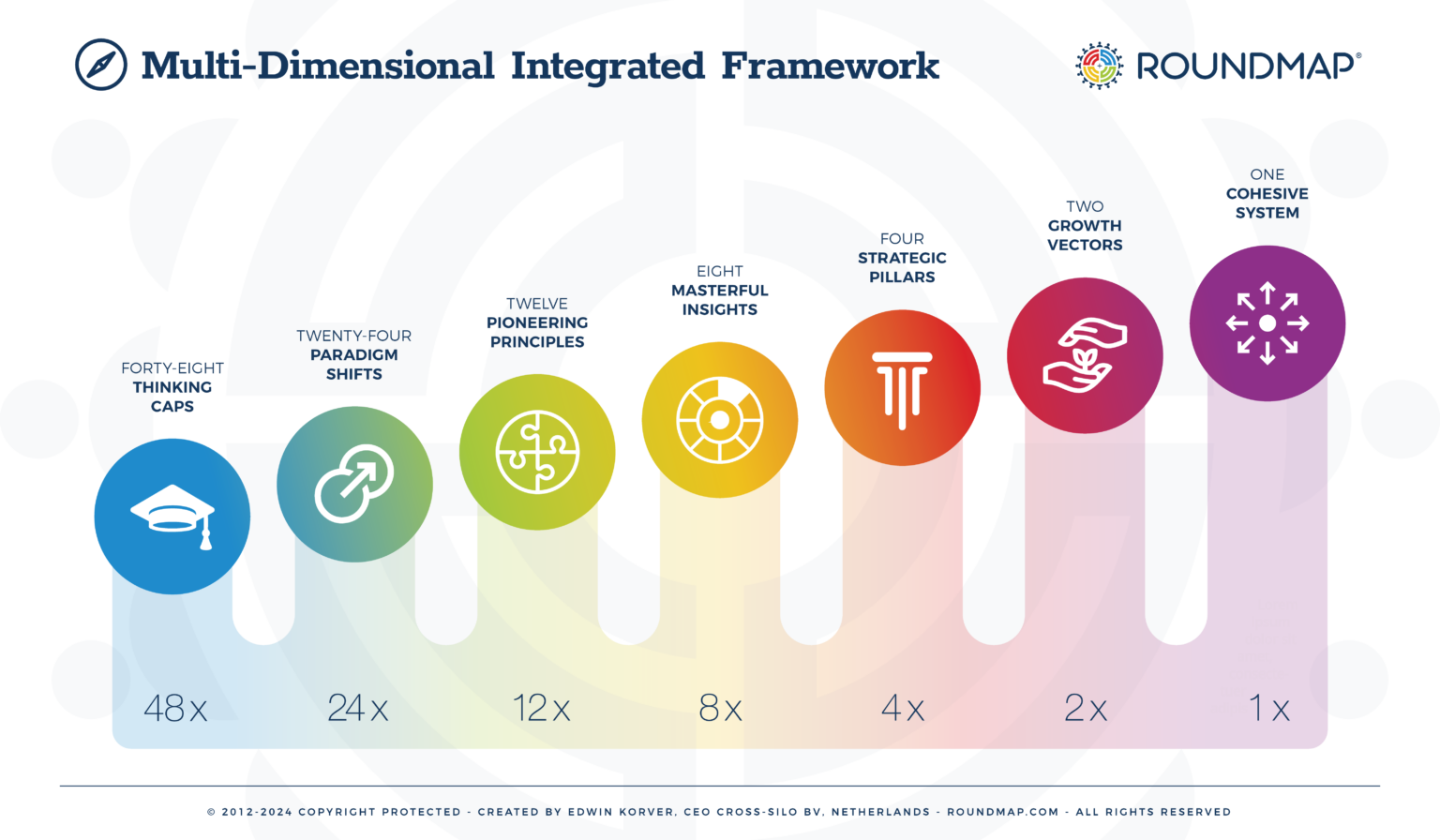Welcome to our guide on the Core Principles of RoundMap®—your compass to conquering business complexities and propelling sustainable growth. RoundMap®, not just a framework but a holistic ecosystem, fortifies modern organizations with crucial insights and strategies sculpted around its foundational principles.
At the heart of RoundMap® lie twelve robust principles (in alphabetical order):
-
All-Encompassing Integration – Merges various business facets into a unified, holistic framework, ensuring a seamless interplay between different operational areas.
-
Applied Systems Thinking – A holistic approach that views an organization as interconnected, emphasizing understanding complex interdependencies and long-term impacts.
-
Augmented Execution – Harnesses the power of technology and advanced intelligence to enhance strategic planning and execution, pushing the boundaries of traditional business practices.
-
Consentric Alignment – Facilitates consent-driven decision-making, distributed from the center to the constellation of teams, thereby enhancing resilience, adaptability, and accountability.
-
Cyclical Evolution – Advocates for continuous improvement through cyclical processes, fostering an environment of perpetual growth and adaptation.
-
Empowered Action – Promotes a leadership style that is collaborative and empowering, distributing responsibilities across the organization to encourage innovation and engagement at all levels.
-
Integrative Diversity – Balances specialized expertise with a broad, holistic understanding, embracing diverse perspectives for comprehensive problem-solving and innovation.
-
Impact-Focused Approach – Prioritizes actions and strategies that yield sustainable and positive impacts within the organization and the wider community.
-
Human-Centric Orientation – Puts people at the forefront, focusing on human needs and experiences to drive organizational success and employee satisfaction.
-
Skillful Mastery – Highlights the importance of skill development and effective utilization, ensuring team members are equipped to contribute their best.
-
Story-Driven Communication – Utilizes the power of storytelling to convey the organization’s values, vision, and mission, creating a compelling and relatable narrative.
-
Whole System Engagement – Concentrates on nurturing the overall health and dynamism of businesses, engaging every aspect of the organization in the journey toward excellence.
Our guide will delve into understanding each of these principles, exploring how they drive the effectiveness of RoundMap® across diverse business contexts. Beyond theoretical knowledge, you’ll gain invaluable insights into implementing these principles, propelling your organization toward sustainable prosperity.
Whether you’re a seasoned leader, a start-up entrepreneur, or an aspiring business professional, gaining insights into these principles will empower you to navigate the intricate corridors of the business landscape confidently. Prepare to embark on a profound learning journey that fundamentally redefines how you perceive and act within the business world.
Unravel the RoundMap® framework, derived from its eight core principles, to illuminate your pathway toward sustained relevance and prosperity. Dig in, and let your journey toward business excellence commence.
Navigating the Twelve Principles of RoundMap
1. All-encompassing Integration
RoundMap® is an all-encompassing framework meticulously designed to integrate every facet of organizational dynamics. Whether addressing strategy, operations, marketing, or stakeholder engagement, RoundMap® offers a holistic view, ensuring that no element is viewed in isolation. It recognizes the interconnectedness of all organizational components and promotes a cohesive approach to decision-making and value delivery.
By providing a comprehensive roadmap transcending departmental silos and industry-specific challenges, RoundMap® empowers organizations to achieve optimal coherence, drive alignment, and ensure that every action contributes harmoniously to the overarching objectives.
2. Applied Systems Thinking
Systems Thinking, as a principle within the RoundMap framework, is an approach that views an organization not just as a collection of independent components but as a cohesive, interconnected whole. This perspective emphasizes understanding how different parts of the organization interact and influence one another, creating a network of relationships that defines the overall system. In Systems Thinking, the focus shifts from isolated issues or challenges to the broader patterns and structures that drive behaviors and outcomes. This holistic view encourages looking beyond immediate causes and effects, considering the longer-term implications and the dynamic interplay of various elements within the system.
Applied Systems Thinking in an organizational context involves recognizing the complex and often subtle interdependencies within and beyond the organization’s boundaries. It prompts leaders and team members to consider how decisions and actions in one area can ripple through the entire system, impacting other areas in ways that may not be immediately obvious. This approach fosters a deeper understanding of the organization’s functioning, enabling more strategic and effective decision-making. By adopting Systems Thinking, organizations can anticipate unintended consequences, identify leverage points for change, and develop solutions that address root causes rather than symptoms, leading to more sustainable and resilient outcomes.
3. Augmented Execution
RoundMap’s augmentative ability is a testament to the integration of expansive thought and cutting-edge technology in business intelligence. Its 48 Thinking Caps gives executives a comprehensive panoptic view of business operations. This multi-faceted perspective allows decision-makers to dive deep into every nook and cranny of their organization, from its strategies and structures to its underlying culture and purpose.
Furthermore, leveraging the power of augmented intelligence with an interactive chat agent, RoundMap® systematically maps out the current business dynamics—highlighting strengths, pinpointing opportunities, identifying challenges, and laying out visions, missions, plans, and more. In an era where business complexities continue escalating, making it increasingly challenging to account for every variable, RoundMap® is an invaluable compass, guiding executives to make informed and strategically sound decisions for their journey.
4. Consentric Alignment
Consentric Alignment, as envisioned in the Consentricity™ model, marks a significant departure from the traditional top-down command-and-control structures still prevalent in many organizations. This innovative approach to organizational design is inspired by the concept of concentric circles, where each circle represents different roles and functions, yet all are interconnected and harmoniously aligned. At its core lies the Circle of Confluence, a pivotal forum where collaborative governance and equitable decision-making occur. Embodying the organization’s highest values, this central circle sets the tone for decision-making, ethical conduct, and cultural resonance, ensuring that these core principles permeate every layer of the organization.
Around the central Circle of Confluence are various concentric circles – including Councilors, Catalysts, Coordinators, and the Constellation of Teams – each with distinct roles but working in an integrated fashion. This structure fosters a consent-based decision-making process, where decisions are not imposed from the top but are reached through collective agreement, respecting and valuing the input of each circle. Such an arrangement promotes inclusivity and ensures that every decision aligns with the organization’s core values and objectives. The Consentricity™ model, therefore, creates a cohesive and harmonious system where the traditional hierarchies are replaced with a more fluid, dynamic, and inclusive form of governance, reflecting a deep commitment to collective success and ethical standards.
5. Cyclical Evolution
At its essence, a market participant is driven by the ethos of efficient value creation and optimization, always aiming for the cost of value production to be lower than the value retrieved upon its delivery to the market. However, in the VUCA (Volatility, Uncertainty, Complexity, and Ambiguity) world, organizations might confront scenarios where the expense of realizing value temporarily surpasses its creation. This deviation doesn’t detract from the ultimate goal of profitability but underscores the imperative of adaptability and building resilience for the future.
Herein lies the significance of cyclical leadership—a leadership style that recognizes the inherent ebb and flow of business cycles, adapting strategies and tactics in response to the changing rhythms of the market. Rather than being linear and fixed in approach, cyclical leaders iterate, pivot, and evolve, ensuring their organization’s long-term viability and competitiveness in perpetually evolving market terrains. This agility and cyclical perspective position organizations to weather challenges and capitalize on emerging opportunities.
6. Empowered Action
RoundMap champions Empowered Action and Distributed Leadership, moving away from traditional leadership models where authority is concentrated at the top. This paradigm shift recognizes that every team member, with their unique blend of skills, knowledge, and experience, plays a vital role in guiding the organization. By empowering individuals at all levels, this approach fosters a culture where responsibility, engagement, and ownership are not just top-down mandates but are ingrained in every aspect of the organization.
Empowered Action offers numerous advantages. It significantly bolsters employee engagement and commitment by giving all members a direct role in decision-making and leadership. This empowerment leads to a surge in innovation as diverse perspectives contribute to creative problem-solving and strategic thinking. Team morale and motivation also soar, driven by collective responsibility and shared achievement. This approach adeptly spreads decision-making and leadership tasks in an era of organizational complexity, ensuring agility and adaptability. Moreover, dispersing authority provides a robust foundation for resilience during change, maintaining continuity and stability. This focus on Empowered Action is not just about distributing tasks; it’s about instilling a sense of leadership at every level, turning the entire organization into a dynamic, responsive, and cohesive entity.
7. Integrative Diversity
Balancing individuals with deep expertise and polymaths – deep and broad knowledge – is crucial for fostering creativity, innovation, complex problem-solving, and synthesis in organizations. Specialists bring focused, in-depth insights, while polymaths contribute wide-ranging perspectives that can bridge diverse areas of knowledge.
This blend enhances the organization’s ability to generate novel ideas, tackle complex issues, and integrate different viewpoints for more comprehensive solutions. It creates a dynamic environment where diverse skills and perspectives coalesce, driving forward-thinking and innovative outcomes.
8. Impact-Focused Approach
The impact-driven core principle of RoundMap® emphasizes driving meaningful change within and beyond an organization. It involves a comprehensive approach to analyzing, formulating, implementing, and evaluating operations based on their impact.
This four-step recursive process integrates impact assessment into the strategic framework, ensuring business objectives align with positive outcomes. An impact-driven organization continuously refines its approach, like maintaining a well-oiled machine, striving to create beneficial changes, differentiate itself, and improve long-term performance while contributing positively to the global landscape.
9. Human-Centric Orientation
Human-centric organizing, anchored in virtuous cycle leadership, revolutionizes organizational culture by emphasizing human value. It fosters environments of psychological safety, enabling open communication and innovation. This approach cultivates resilience and adaptability, enhancing stakeholder satisfaction and aligning internal and external success.
The virtuous cycle principle underlines the reciprocal benefits of caring for employees and customers, reinforcing that valuing individuals drives transformative growth. Integrating this theory encourages organizations to focus on their people, creating a thriving internal ecosystem that promotes sustained growth and shared prosperity.
10. Skillful Mastery
Skills-First, a pioneering principle in modern talent acquisition, revolutionizes traditional hiring paradigms by prioritizing the development of essential competencies over static qualifications. This strategic approach recognizes that an individual’s skill set, practical abilities, and aptitudes indicate their potential success in a role more than conventional markers such as degrees or certifications. It represents a departure from the one-size-fits-all mentality, fostering an environment where diverse skills contribute to a dynamic and enriched workplace. Embracing Skills-First ensures real-world relevance, promotes diversity and inclusion, and positions organizations to adapt swiftly to evolving industry landscapes.
This transformative philosophy enhances recruitment strategies and unlocks the full potential of individuals within an organization. By valuing and cultivating diverse skills, Skills-First allows for tailored development paths, fostering a meritocratic environment where advancement is based on demonstrated abilities. This approach enhances employee engagement and satisfaction and acts as a proactive strategy for future-proofing talent, ensuring organizations are equipped with the capabilities needed to stay competitive in an ever-evolving business landscape.
11. Story-Driven Communication
Storytelling, an age-old art, plays an invaluable role in the intricate dance of value signaling. Whether illuminating a compelling need or showcasing an abundant surplus, a well-crafted story built upon a riveting plot can evoke emotions, drive action, and foster connections. Enter the realm of StoryCasting™, a dynamic fusion of storytelling and casting a line, much like an angler aiming to attract fish. Storycasting is a strategic lure in business, drawing customers into a brand’s narrative.
At its heart, every potent story pivots on its plot—a series of interconnected events or moments that lay the foundation for the narrative. Through this plotted journey, brands can effectively communicate their value propositions, resonating with the desires and aspirations of their audience. As such, a masterfully told story informs and beckons, guiding listeners toward the intended value, be it a call to action or an invitation to partake in a surplus offering.
12. Whole System Engagement
Whole System Engagement, as a key principle of RoundMap®, is a transformative approach that integrates the entire human system of an organization into the process of change and development. Rooted in the principles of Appreciative Inquiry, this method centers on discovering and amplifying the existing strengths of an organization – its team, management, systems, and processes. Rather than focusing solely on fixing problems, it encourages exploring and building upon what already works well. This positive focus creates a fertile ground for innovation and growth.
In this approach, every individual in the organization is invited to participate in shaping its future. This inclusive, collaborative process not only ensures a deeper understanding and alignment with the organization’s mission but also fosters a sense of ownership and commitment among all stakeholders. By empowering individuals to contribute their insights and ideas, Whole System Engagement leads to more robust, sustainable changes. It’s a shift from traditional top-down decision-making to a more democratic, bottom-up approach, where change is co-created, reflecting the collective aspirations and strengths of the entire organization.





